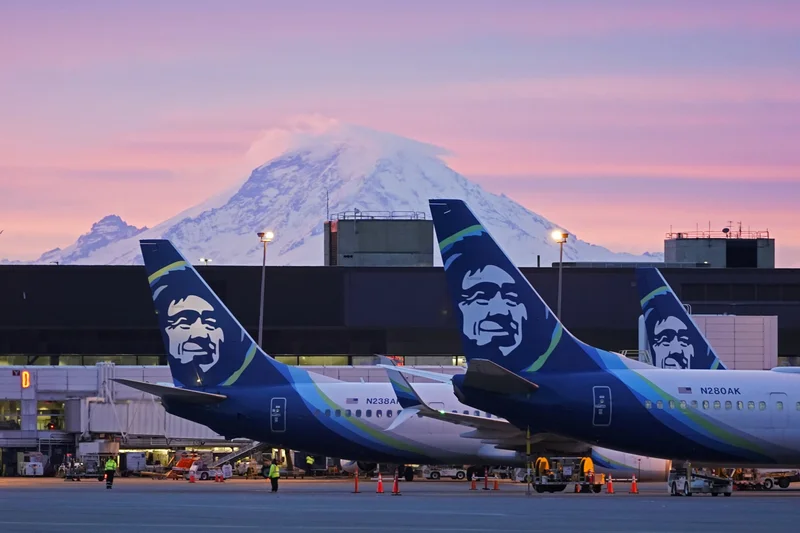Article Directory
Alaska's Seven-Hour Freeze: More Than Just an IT Glitch
An airline doesn’t just stop. Not in 2025. Yet on Thursday, October 23rd, that’s precisely what Alaska Airlines did. For seven hours, starting around 3:30 p.m. Pacific Time, the carrier’s entire U.S. operation was frozen in place by a self-described “failure” at its primary data center. The immediate result is easy to quantify: a nationwide ground stop, more than 360 canceled flights, and disruptions for roughly 50,000 passengers—to be more exact, an estimated 49,000.
The images from Sea-Tac airport—mounds of unclaimed suitcases accumulating like geological formations in the baggage claim, and lines of travelers snaking through the concourse—tell a story of logistical chaos. But the real story isn’t about lost luggage or missed connections. That’s just the anecdotal noise. The real story is about systemic risk, corporate messaging, and a pattern of fragility that should concern any investor looking at the company’s balance sheet. When an airline’s digital heart stops beating for seven hours, it’s not just a glitch. It’s a symptom of a much deeper condition.
The Anatomy of a Systemic Failure
Alaska Airlines was quick to issue a statement confirming the outage was not a cybersecurity incident. This is standard corporate procedure: rule out the scariest-sounding scenario first to prevent a full-blown panic. But the clarification, as summarized by reports that Alaska Airlines cancels 360 flights, says significant IT outage was due to 'failure' at a data center, raises more questions than it answers. If it wasn’t an outside attack, what was it? The term “failure” is analytically useless. Was it a power loss? A cooling system malfunction? A catastrophic software bug during a routine update? The company’s silence on the specifics is, itself, a critical data point.
A modern airline's IT infrastructure isn't supposed to be a single lightbulb that can burn out, plunging everything into darkness. It’s meant to function like a city’s power grid, with redundant substations and automated failover systems designed to reroute power seamlessly. If one data center goes down, a secondary one is supposed to kick in within minutes, not hours. A seven-hour, system-wide outage suggests the problem isn’t a single faulty transformer; it points to a foundational issue with the entire grid. Why did the backup systems not perform as designed? Was there even a true, hot-swappable backup, or was the contingency plan something far less robust?
The company’s statement that "The safety of our flights was never compromised" is technically true, as planes were on the ground. But it sidesteps the more salient point: the operational integrity of the entire business was compromised. An airline that cannot track its planes, crews, and passengers is, for all intents and purposes, not an airline. It’s just a collection of very expensive, stationary aluminum tubes. The decision to cancel the third-quarter earnings call scheduled for the next day (a move that often signals a desire to control the narrative before facing analyst questions) further indicates that the company knew this was far more than a simple operational hiccup.

A Pattern of Fragility
This event cannot be analyzed in a vacuum. This was the second major IT outage for Alaska Airlines in just three months, following a similar, albeit shorter, disruption in July. In data analysis, one event is an anomaly. Two events in close succession is a trend line. And that trend line is pointing sharply downward.
I’ve looked at hundreds of corporate filings, and this is the part of the picture that I find genuinely puzzling when set against their financials. The company’s most recent earnings report showed a 69% year-over-year decrease in profit, landing at $123 million, even as revenue inched up by 1.4% to $3.8 billion. A profit collapse of this magnitude while revenue holds steady is a classic indicator of soaring operational costs or significant capital expenditures that aren't paying off. It suggests something is getting very, very expensive under the hood.
Could that "something" be a creaking, aging IT infrastructure that requires constant, costly emergency maintenance? The promise to "diagnose our entire IT infrastructure" feels less like a proactive measure and more like a reactive, public-facing statement designed to placate investors. A proper diagnosis isn't a two-week affair; it's a multi-year, multi-billion dollar commitment to modernization. Is the airline truly prepared for that, or is this just a patch job until the next failure? The most telling data point might be the one that’s missing: Alaska has not yet provided an estimate of the financial impact on its fourth-quarter results. That number, when it finally arrives, will speak volumes.
The True Cost is in the Code
The immediate financial hit from canceled flights and passenger compensation is the headline number, but it’s a distraction. The real, long-term cost is the erosion of operational reliability. The most damning piece of evidence from the entire event is that Hawaiian Airlines, a newly acquired subsidiary, was completely unaffected. This proves the failure was not in some shared, modern cloud service but was endemic to Alaska's legacy core systems. It’s a problem of their own making.
This seven-hour freeze wasn’t an unforeseen accident. It was the result of accumulated technical debt—years of choosing to patch instead of replace, to maintain instead of modernize. That debt just came due, with an interest payment measured in thousands of ruined travel plans and millions of dollars in lost revenue. The airline will recover, but the underlying vulnerability remains. Until the company addresses the rot in its digital foundation, this won’t be the last time we see Alaska Airlines grounded not by weather, but by its own code.
